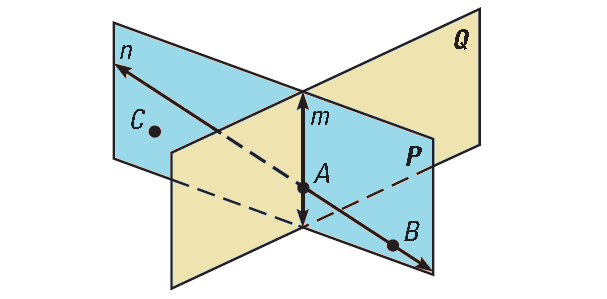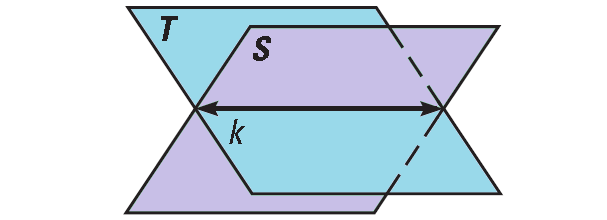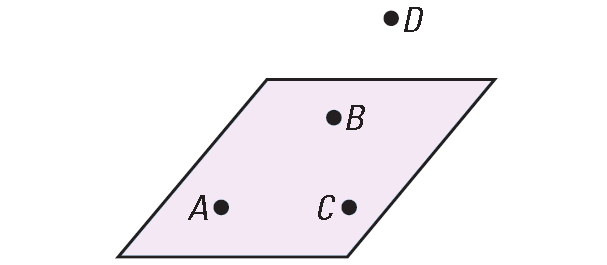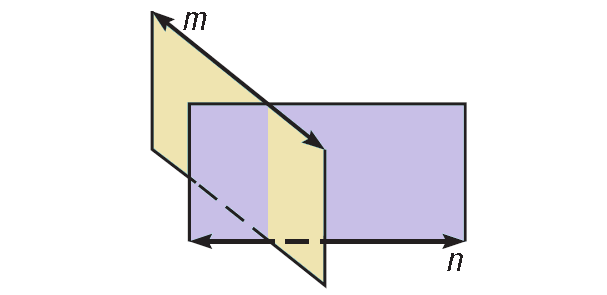POINT LINE AND PLANE POSTULATES WORKSHEET
Subscribe to our ▶️ YouTube channel 🔴 for the latest videos, updates, and tips.
Problem 1 :
Use the diagram shown below to give examples of point line and plane postulates.

Problem 2 :
(i) Rewrite the following postulate in 'if-then' form.
"A plane contains at least three noncollinear points"
(ii) Write the inverse, converse and contrapositive of the above postulate.
Problem 3 :
Decide whether the statement is true or false. If it is false, give a counter example.
(i) A line can be in more than one plane.
(ii) Four noncollinear points are always coplanar.
(iii) Two intersecting lines can be noncoplanar.

Detailed Answer Key
Problem 1 :
Use the diagram shown below to give examples of point line and plane postulates.

Solution :
Postulate 1 :
There is exactly one line (line n) that passes through the points A and B.
Postulate 2 :
Line n contains at least two points. For instance, line n contains the points A and B.
Postulate 3 :
Lines m and n intersect at point A.
Postulate 4 :
Plane P passes through the noncollinear points A, B and C.
Postulate 5 :
Plane P contains at least three noncollinear points A, B and C.
Postulate 6 :
Points A and B lie in plane P. So, line n, which contains points A and B, also lies in plane B.
Postulate 7 :
Planes P and Q intersect. So, they intersect in a line, labeled in the diagram as line m.
Problem 2 :
(i) Rewrite the following postulate in 'if-then' form.
"A plane contains at least three noncollinear points"
(ii) Write the inverse, converse and contrapositive of the above postulate.
Solution (i) :
"A plane contains at least three noncollinear points"
The above postulate can be written in 'if-then' form as follows :
If two points are distinct, then there is exactly one line that passes through them.
Solution (ii) :
"A plane contains at least three noncollinear points"
Inverse :
If two points are not distinct, then it is not true that there is exactly one line that passes through them.
Converse :
If exactly one line passes through two points, then the two points are distinct.
Contrapositive :
If it is not true that exactly one line passes through two points, then the two points are not distinct.
Problem 3 :
Decide whether the statement is true or false. If it is false, give a counter example.
(i) A line can be in more than one plane.
(ii) Four noncollinear points are always coplanar.
(iii) Two intersecting lines can be noncoplanar.
Solution (i) :
In the diagran shown below, line k is in plane S and line k is in plane T.

So, it is true that a line can be in more than one plane.
Solution (ii) :
Consider the points A, B, C and D shown below. The points A, B and C lie in a plane, but there is no plane that contains all four points.

So, as shown in the counter-example above, it is false that four noncollinear points are always coplanar.
Solution (iii) :
In the diagram shown below, line m and line n are non intersecting and are also noncoplanar.

So, it is true that two nonintersecting lines can be noncoplanar.
Subscribe to our ▶️ YouTube channel 🔴 for the latest videos, updates, and tips.
Kindly mail your feedback to v4formath@gmail.com
We always appreciate your feedback.
About Us | Contact Us | Privacy Policy
©All rights reserved. onlinemath4all.com

Recent Articles
-
90 Degree Clockwise Rotation
Jan 01, 26 06:58 AM
90 Degree Clockwise Rotation - Rule - Examples with step by step explanation -
US Common Core K-12 Curriculum Algebra Solving Systems of Equations
Jan 01, 26 04:51 AM
US Common Core K-12 Curriculum - Algebra : Solving Systems of Linear Equations -
Solving the HARDEST SAT Math Questions ONLY using Desmos
Dec 31, 25 05:53 AM
Solving the HARDEST SAT Math Questions ONLY using Desmos
